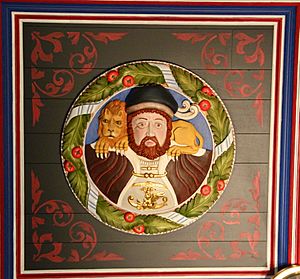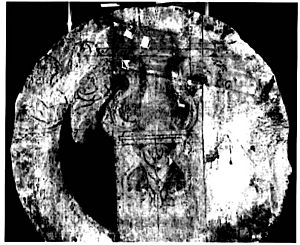Andrew Mansioun facts for kids

Andrew Mansioun (died 1579) was a talented French artist and craftsman. He worked for the Scottish royal family, including James V, King of Scots, Mary, Queen of Scots, and James VI of Scotland. He was known as the master carpenter for the Scottish artillery.
Contents
What Did Andrew Mansioun Do?
Andrew Mansioun was a very skilled craftsman. He carved beautiful wooden decorations and engraved metal. He also made molds for iron decorations and helped make cannons.
He might have worked on the famous 34 'Stirling Head' oak carvings around 1540. These were made for Stirling Castle. He also created special fittings for the royal yacht Unicorn. In 1541, he engraved a brass plate for a tomb in Markinch. The next year, he carved a lion and a Latin message for King James V's tomb.
Andrew also made a cradle for Prince James, the son of James V. He even made a bed for Regent Arran.
Making Royal Cannons
Andrew Mansioun was very important in making cannons. He created molds to put the royal symbols, like the king's coat of arms, on the cannon barrels. He also engraved dates and special marks on the guns.
In 1543, he became a gunner in the Scottish army. He earned a good salary for his work. The gun foundry, where cannons were made, was at Edinburgh Castle. Andrew engraved royal cannons with symbols like unicorns, thistles, and fleur-de-lys.
Some cannons with King James V's royal symbols were captured by the English. One was even found in a loch and is now in a museum in Glasgow.
The Stirling Heads
The Stirling Heads are famous round carvings made for the King's room ceiling at Stirling Castle in 1540. They were carved from oak wood that came all the way from Poland.
These carvings were originally painted in bright colors. Experts found traces of blue-grey paint that showed the steel armor of some figures. Similar stone carvings can be seen at Falkland Palace.
The Stirling Heads show different subjects. These include kings from the Stewart family, characters from old myths, and Bible stories. For the castle's restoration in 2010, new medallions were carved and painted.
During the study of the Stirling Heads, a drawing was found on the back of one carving. It showed a woman in a mask costume. This drawing might have been made by Andrew Mansioun himself.
Working for Edinburgh Town
Andrew Mansioun also worked for the city of Edinburgh. He made stools for St Giles Cathedral. In 1554, he finished the choir stalls and a new door for the church. He had a team of carpenters working with him.
He also helped the town council with big projects. In 1555, he helped raise the new timber frame for the Tolbooth belfry and steeple. This was a huge task that needed 28 men working together.
Later in 1555, Mansioun was on the island of Inchkeith. He was in charge of horses and winches. This was for building a fortress designed by an architect named Lorenzo Pomarelli for Mary of Guise.
An Altarpiece for Holyrood Palace
In 1559, Mary of Guise had a new altarpiece installed at the Chapel Royal in Holyrood Palace. She ordered paintings from Flanders for it. Andrew Mansioun helped by making the frame for this important artwork.
Working for Mary, Queen of Scots
On December 28, 1561, Mary, Queen of Scots gave Andrew Mansioun a special job for life. He became the 'Master Carpenter and Gunner'. This meant he had a good monthly salary. When he passed away in 1579, his son Francis took over his position.
It's thought that Andrew Mansioun also made a cradle for Prince James in 1566. This was when the queen was expecting her son's birth at Edinburgh Castle.
His Life and Family
We don't know much about where Andrew Mansioun came from. But records always say he was French. He was injured while defending Edinburgh Castle from an English attack in 1544. One of his own cannons backfired, hurting his hand. He later received more money to make up for his injury.
Andrew lived in Edinburgh and had his own workshop. He joined the local group of skilled craftsmen, like masons and carpenters. He even helped decide if other carpenters were good enough to become master craftsmen. He was also an elder in the church and served on the local town council.
Andrew Mansioun received his last payment in April 1579, so he likely passed away around that time.
Many of his family members continued his work as carpenters. His son, Francis Mansioun, became a gunner at Edinburgh Castle after him. Francis was also a leader of the carpenters' trade group in Edinburgh. He even made an oak pulpit for a church in Falkland in 1602. Other family members, like Joshua and Isaac Mansioun, also became important carpenters in Edinburgh.
See Also
- Domestic furnishing in early modern Scotland
- Stirling Heads
Images for kids





